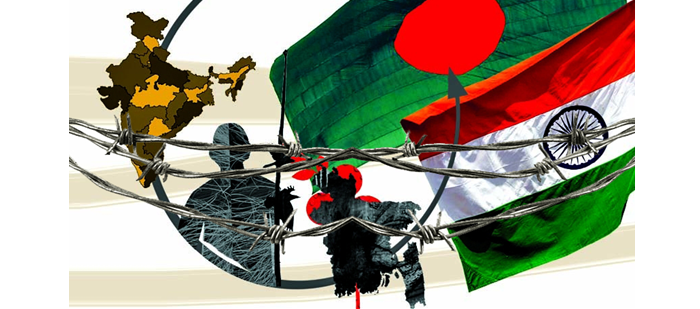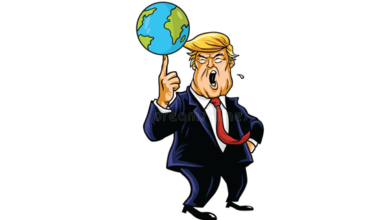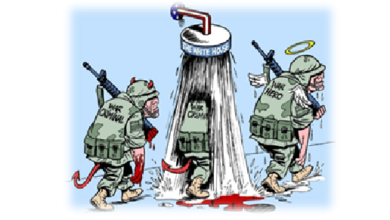Bangladesh and India: The Grave Consequences of Border Issues and Domestic Politics
Sheikh Hasina Wajid, Relations with India, and Bangladesh’s Internal Struggles
The India-Bangladesh border dispute is intensifying, particularly along the extensive boundary shared by the state of West Bengal with five districts of Bangladesh. At a time when the political landscape in Bangladesh is undergoing a transformation, tensions along the border with neighbouring India have escalated. This became evident when Colonel Rafique Islam, commander of the 58th Battalion of Bangladeshi Border Guards (BGB), issued a statement to Bangladeshi media on Tuesday, claiming that “a five-square-kilometre area along the banks of the Kotlia River has been occupied.”
In recent days, several significant incidents have occurred in this border region, leading to heightened tensions and unease between India’s Border Security Force (BSF) and Bangladesh’s Border Guards (BGB). Normally a relatively calm area, this border has recently witnessed noticeable tension, especially over the past week. This led to an emergency ‘flag meeting’—a formal meeting between the two forces—to address the escalating situation.
The immediate trigger for the meeting was the reported occupation of five square kilometres along the Kotlia River by Bangladesh. Both countries discussed measures to de-escalate the issue during the meeting. Whether the concern is preventing border infiltration or installing barbed wire fences on the Indian side, regular meetings between the BSF and BGB are commonplace. While no confirmed reports of clashes between the two forces have emerged, the situation remains strained in several areas.
One of the most critical locations in West Bengal is the Petrapole border post in the North 24 Parganas district, a heavily trafficked checkpoint where Bangladeshi border guards are also stationed.
The disputed territory along the Kotlia River, claimed by Bangladesh, falls within the Bagda constituency’s Ranaghat village, located near the Petrapole border post. On the opposite side of the border lies Maheshpur in Bangladesh. Following Rafique Islam’s statement, tensions rose between the two nations. However, border officials stated that the situation was quickly brought under control and further deterioration was prevented.
Amidst these developments, Bangladesh’s Foreign Secretary Mohammad Jashim Uddin summoned Indian High Commissioner Pranay Verma in Dhaka to express “deep concern” over the recent activities of the Indian Border Security Force (BSF). He conveyed a message urging Indian authorities to refrain from “provocative actions.” Highlighting attempts to erect barbed wire fencing along the border, which he deemed “illegal,” Jashim Uddin warned that such actions could escalate tensions between the two countries.
Indian media reported that Jashim Uddin accused India of violating bilateral agreements, specifically regarding fencing at five locations along the border, and demanded an immediate halt to such activities.
In response, ahead of the emergency flag meeting at Petrapole, the BSF categorically rejected Rafique Islam’s claims, calling them baseless and misleading. “The BSF assures that not an inch of land has been occupied, nor will we permit such actions,” stated an official. The Indian Border Security Force clarified that the international boundary runs along the middle of the Kotlia River and is already well-demarcated with boundary markers and stones on both sides to delineate the border clearly.
This raises the question of what prompted the immediate need for the flag meeting.
Colonel Rafique Islam further claimed in his statement that, historically, residents of Bangladeshi border villages had faced difficulties accessing the Kotlia River. However, he asserted that the current situation had enabled them to utilise the river’s waters freely. In response, Indian BSF officials stated that residents on both sides of the river have always accessed the water within their respective territories, and this remains unchanged. Notably, this section of the border lacks barbed wire fencing.
The Leader of the Opposition in the West Bengal Legislative Assembly, Suvendu Adhikari, shared a video of the incident on his social media page, which led to a temporary halt in the work of installing barbed wire fencing. The Indian Border Security Force (BSF) stated that Bangladeshi border guard officials were informed about the installation of barbed wire along the Indian border. The BSF clarified to the Bangladeshi security officials that the barbed wire installation was being carried out based on a bilateral agreement between the two nations. Speaking to reporters, Neelotpal Pandey said that after resolving the misunderstanding, the installation work resumed.
In a post on social media platform ‘X,’ Suvendu Adhikari, a leader of India’s ruling Bharatiya Janata Party (BJP), remarked that Bangladeshi border guards were compelled to retreat due to the nationalist sentiments of the people in Sukhdipur village. He further stated that the local Indian citizens, in collaboration with the BSF, made it clear to the Bangladeshi Border Security Force that such attempts would not be tolerated in the interest of national security. Adhikari credited this to the growing awareness among the people.
Meanwhile, another video has gone viral on social media, allegedly showing “suspected Bangladeshi smugglers” clashing with BSF personnel in the Mukuroli area of Kailashahar, Tripura.
Since the formation of Bangladesh in 1971, the country has maintained friendly relations with India, ensuring that tensions on the India-Bangladesh border remained minimal. Trade and movement of people between the two nations continued smoothly. However, recent developments in Bangladesh suggest that tensions might arise. Residents of border villages have always been vigilant about their security. In areas where barbed wire fencing is absent, locals have taken proactive measures for their safety. They have started installing surveillance cameras and patrolling at night to ensure security.
India has long considered alleged infiltration from Bangladesh a major issue, and this concern often resurfaces during elections in various Indian states. Political parties use this issue to attack each other in the border regions. The BJP prominently raised the issue of infiltration during the Delhi Assembly elections in February. In West Bengal, the ruling Trinamool Congress (TMC) and the BJP frequently engage in heated exchanges on this matter.
Chief Minister Mamata Banerjee, during her annual meeting with officials, highlighted areas where infiltration is allegedly taking place. While reviewing the state secretariat’s departments, Banerjee remarked, “Border security is not the responsibility of the TMC or the state police. It is the job of the Border Security Force. They are facilitating infiltration and aiding criminal activities. I will take action against them and write to the central government regarding this.”
Banerjee also named three border regions in West Bengal where infiltration is reportedly most prevalent. Following her statement, Deputy Commissioner of Police Neelotpal Kumar Pandey from the BSF’s South Bengal border area released a statement saying such remarks demoralise BSF personnel. He asserted that the BSF is a “responsible force” and is fulfilling its duties with integrity. He also clarified that despite the Bangladeshi border official’s confusing statements, the situation in the border areas remains unchanged, with peace prevailing on both sides.
Another incident occurred on Tuesday in Sukhdipur village of Malda district, where barbed wire installation was underway. Bangladeshi Border Security Force personnel attempted to halt the work, leading to tensions in the border area. Villagers from Sukhdipur gathered at the site, chanting slogans such as “Bharat Mata ki Jai,” “Jai Shri Ram,” and “Vande Mataram.”
Meanwhile, the BJP has adopted an aggressive stance against Mamata Banerjee’s statement. Opposition leader Suvendu Adhikari wrote a letter to the Chief Minister, raising several questions. He stated that security forces’ officers and soldiers serve the nation and protect its borders even in the harshest conditions. He warned that the country would not forgive disparaging remarks about the armed forces.
Adhikari questioned how local authorities issue ration cards and identification documents to infiltrators who cross the border and take refuge in villages, and how police officials verify their credentials. In his letter, he alleged that the West Bengal government is not cooperating with the BSF in installing barbed wire fencing. He also highlighted that the state government has been slow in allocating land for approximately 300 kilometres of barbed wire fencing along the Bangladesh border.
It should be noted that when the student movement in Bangladesh for securing government jobs turned into violent anti-government protests, Sheikh Hasina Wajed, the ruthless former Prime Minister who had held power for 15 years under the guise of democracy, was forced to flee. She sought refuge under her ally, Narendra Modi, and has since been living under strict security. In this entire episode, Sheikh Hasina’s favoured appointee, General Waqar Uz Zaman, the Army Chief of Bangladesh, played a central role. He not only provided a helicopter for Sheikh Hasina’s escape but, under pressure from the students, appointed Nobel laureate Muhammad Yunus as the interim head of government. Furthermore, several political opponents, including former Prime Minister Khaleda Zia, were also released.
This extraordinary and sudden political shift caught the Modi government off guard. Meanwhile, Sheikh Hasina’s son, Sajeeb Wajed, in an interview with international media, blamed Pakistan for the change in Bangladesh, expressing concerns that the political future of Bangladesh could mirror that of Pakistan. He warned, “Islamist extremists, whom our government had painstakingly contained, may resurge, and Bangladesh may turn into another Pakistan.”
Pakistan’s Ministry of Foreign Affairs declined to comment on this statement. However, several former Pakistani diplomats, when contacted, dismissed the comparison as flawed and baseless. Political analysts observing Bangladesh’s situation have expressed mixed opinions on the matter. Dhaka-based lawyer Rizwana Muslim, responding on the same international media platform, refuted Sajeeb Wajed’s statement, stating, “This is an emotional and biased remark with no truth. It’s crucial to understand that Islamist leaders no longer exist in Bangladesh. The former Awami League government eradicated all political parties that could harm its long-term interests, including Jamaat-e-Islami, whose key leaders were executed, thousands of members imprisoned in dark cells, and the party itself banned. Its leadership is now largely in exile. The student movement does not favour religious governance or old political faces, so the situation today is vastly different.”
New Delhi-based journalist Jayanta Roy Chowdhury also disagreed with the comparison between Bangladesh and Pakistan. Responding to Sajeeb Wajid, he pointed out, “If we compare Bangladesh with other countries in the region, it has outpaced not only Pakistan but also India in development. Bangladesh is currently the world’s largest exporter of ready-made garments. However, we must not overlook Sheikh Hasina’s repression of opponents and rampant corruption, which has been highlighted in British media, specifically involving her niece.”
It is worth recalling that after the fall of Dhaka in 1971, Bangladesh was South Asia’s poorest country, with its economic conditions so dire that US National Security Advisor Henry Kissinger labelled it a “basket case.” The situation worsened in 1974 with a devastating flood and subsequent famine, during which US President Richard Nixon’s administration halted aid to Bangladesh. However, nearly 52 years later, Bangladesh has emerged as one of South Asia’s fastest-growing economies.
Experts in Bangladesh attribute this progress primarily to non-governmental organisations such as Muhammad Yunus’s Grameen Bank and Fazle Hasan Abed’s BRAC. Jayanta Roy Chowdhury, responding to another query, stated, “In India, there is more concern about Bangladesh turning into Afghanistan than Pakistan.” He drew parallels with the Taliban regime of the 1990s, stating, “At that time, many Bangladeshi youth, inspired by the Taliban, moved to Afghanistan and fought for them. After the Taliban’s fall, these young men returned to Bangladesh.”
He noted that this was a period when Sheikh Hasina’s government had been ousted, and the Bangladesh Nationalist Party (BNP) came to power. He warned that groups supporting the Taliban ideology could become active again, saying, “The greater concern is not about becoming Pakistan but about Bangladesh potentially turning into Afghanistan.”
However, the Institute of Strategic Studies in Pakistan’s India Study Centre highlighted key structural differences between Pakistan and Bangladesh. In Pakistan, the military has ruled for extended periods, whereas Bangladesh has consistently experienced democratic governments, especially since the 2000s. Bangladesh has shown a stronger economy, greater empowerment of women, and a robust student union with a better understanding of politics. The nation’s unique culture, language, and emphasis on democratic values further strengthen its fabric.
Comparing Bangladesh to Pakistan, it becomes evident that military rule is unlikely to occur in Bangladesh. Even if a hybrid political system were introduced, it would not last long. It is noteworthy that when the Bangladeshi military chief announced the end of Sheikh Hasina’s government and proposed forming an interim government, the student unions rejected this outright. They nominated Nobel laureate Muhammad Yunus as their candidate. The military officers advised their chief to accept the students’ demands, leading to negotiations with the students and eventually inviting Yunus to form a government.
The strong student union of Bangladesh has also announced that their active movement will limit the role of the military in politics, as they have loyalists and supporters within the military. The primary reason for the support group within the army is Sheikh Hasina’s tendency to promote loyal military personnel within her party, the Awami League. A clear example of this can be seen with the army chief, Waqar-ul-Zaman, whose loyalty was initially with Sheikh Hasina and the Awami League. His assistance in Hasina’s escape indicates that he repaid her kindness by helping her flee. However, the student union now does not want Sheikh Hasina or her remnants to be a part of the forthcoming government. Therefore, Pakistan and Bangladesh are quite different from each other.






